Sungyong Seo
Test of Time: A Benchmark for Evaluating LLMs on Temporal Reasoning
Jun 13, 2024



Abstract:Large language models (LLMs) have showcased remarkable reasoning capabilities, yet they remain susceptible to errors, particularly in temporal reasoning tasks involving complex temporal logic. Existing research has explored LLM performance on temporal reasoning using diverse datasets and benchmarks. However, these studies often rely on real-world data that LLMs may have encountered during pre-training or employ anonymization techniques that can inadvertently introduce factual inconsistencies. In this work, we address these limitations by introducing novel synthetic datasets specifically designed to assess LLM temporal reasoning abilities in various scenarios. The diversity of question types across these datasets enables systematic investigation into the impact of the problem structure, size, question type, fact order, and other factors on LLM performance. Our findings provide valuable insights into the strengths and weaknesses of current LLMs in temporal reasoning tasks. To foster further research in this area, we are open-sourcing the datasets and evaluation framework used in our experiments: https://huggingface.co/datasets/baharef/ToT.
When Physics Meets Machine Learning: A Survey of Physics-Informed Machine Learning
Mar 31, 2022

Abstract:Physics-informed machine learning (PIML), referring to the combination of prior knowledge of physics, which is the high level abstraction of natural phenomenons and human behaviours in the long history, with data-driven machine learning models, has emerged as an effective way to mitigate the shortage of training data, to increase models' generalizability and to ensure the physical plausibility of results. In this paper, we survey an abundant number of recent works in PIML and summarize them from three aspects: (1) motivations of PIML, (2) physics knowledge in PIML, (3) methods of physics knowledge integration in PIML. We also discuss current challenges and corresponding research opportunities in PIML.
Controlling Neural Networks with Rule Representations
Jun 14, 2021



Abstract:We propose a novel training method to integrate rules into deep learning, in a way their strengths are controllable at inference. Deep Neural Networks with Controllable Rule Representations (DeepCTRL) incorporates a rule encoder into the model coupled with a rule-based objective, enabling a shared representation for decision making. DeepCTRL is agnostic to data type and model architecture. It can be applied to any kind of rule defined for inputs and outputs. The key aspect of DeepCTRL is that it does not require retraining to adapt the rule strength -- at inference, the user can adjust it based on the desired operation point on accuracy vs. rule verification ratio. In real-world domains where incorporating rules is critical -- such as Physics, Retail and Healthcare -- we show the effectiveness of DeepCTRL in teaching rules for deep learning. DeepCTRL improves the trust and reliability of the trained models by significantly increasing their rule verification ratio, while also providing accuracy gains at downstream tasks. Additionally, DeepCTRL enables novel use cases such as hypothesis testing of the rules on data samples, and unsupervised adaptation based on shared rules between datasets.
Network Inference from a Mixture of Diffusion Models for Fake News Mitigation
Aug 08, 2020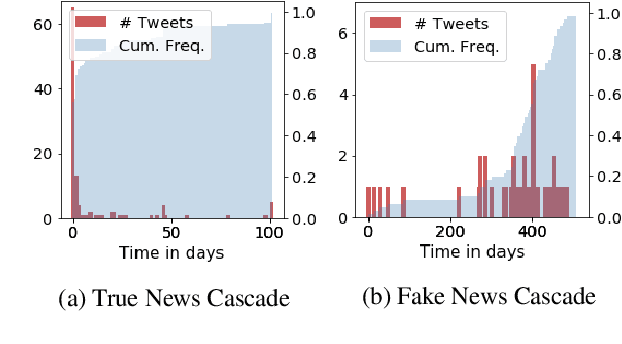
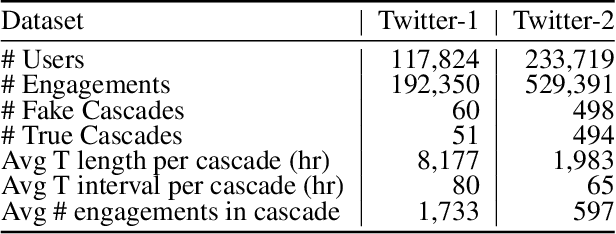
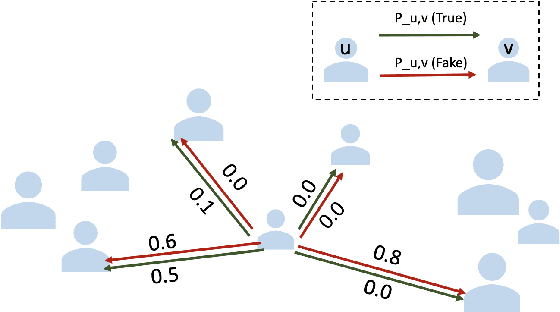
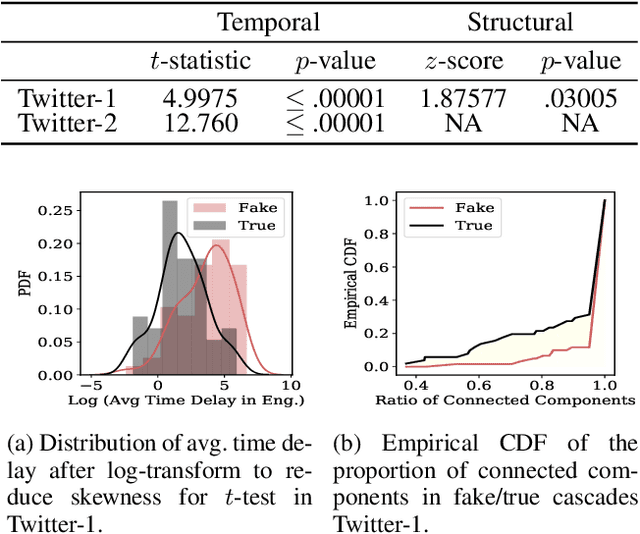
Abstract:The dissemination of fake news intended to deceive people, influence public opinion and manipulate social outcomes, has become a pressing problem on social media. Moreover, information sharing on social media facilitates diffusion of viral information cascades. In this work, we focus on understanding and leveraging diffusion dynamics of false and legitimate contents in order to facilitate network interventions for fake news mitigation. We analyze real-world Twitter datasets comprising fake and true news cascades, to understand differences in diffusion dynamics and user behaviours with regards to fake and true contents. Based on the analysis, we model the diffusion as a mixture of Independent Cascade models (MIC) with parameters $\theta_T, \theta_F$ over the social network graph; and derive unsupervised inference techniques for parameter estimation of the diffusion mixture model from observed, unlabeled cascades. Users influential in the propagation of true and fake contents are identified using the inferred diffusion dynamics. Characteristics of the identified influential users reveal positive correlation between influential users identified for fake news and their relative appearance in fake news cascades. Identified influential users tend to be related to topics of more viral information cascades than less viral ones; and identified fake news influential users have relatively fewer counts of direct followers, compared to the true news influential users. Intervention analysis on nodes and edges demonstrates capacity of the inferred diffusion dynamics in supporting network interventions for mitigation.
Physics-aware Spatiotemporal Modules with Auxiliary Tasks for Meta-Learning
Jun 15, 2020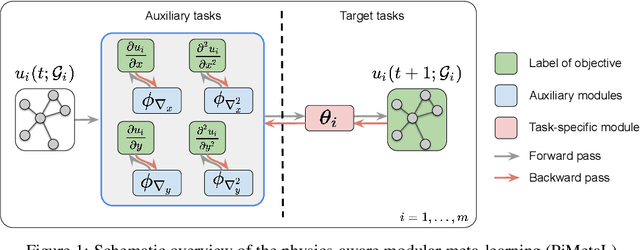
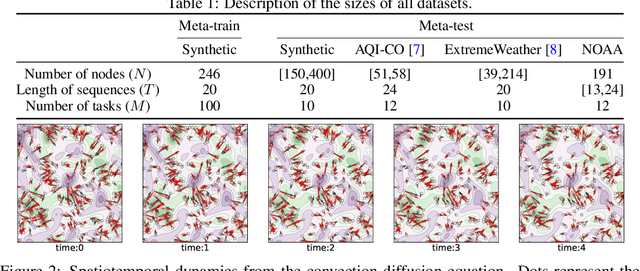
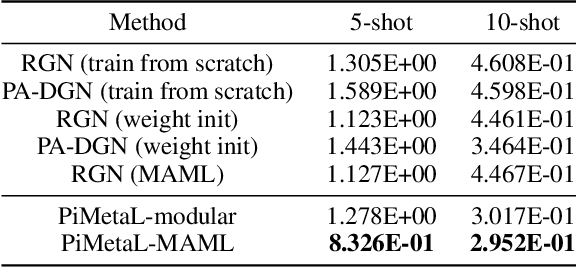
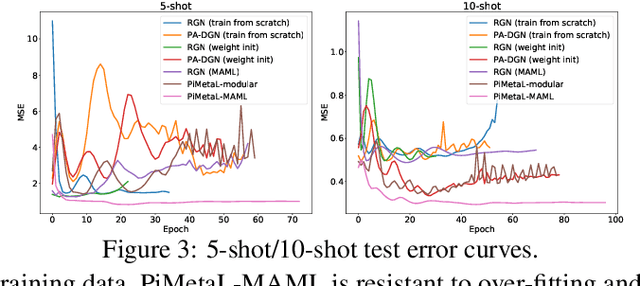
Abstract:Modeling the dynamics of real-world physical systems is critical for spatiotemporal prediction tasks, but challenging when data is limited. The scarcity of real-world data and the difficulty in reproducing the data distribution hinder directly applying meta-learning techniques. Although the knowledge of governing partial differential equations (PDEs) of the data can be helpful for the fast adaptation to few observations, it is difficult to generalize to different or unknown dynamics. In this paper, we propose a framework, physics-aware modular meta-learning with auxiliary tasks (PiMetaL) whose spatial modules incorporate PDE-independent knowledge and temporal modules are rapidly adaptable to the limited data, respectively. The framework does not require the exact form of governing equations to model the observed spatiotemporal data. Furthermore, it mitigates the need for a large number of real-world tasks for meta-learning by leveraging simulated data. We apply the proposed framework to both synthetic and real-world spatiotemporal prediction tasks and demonstrate its superior performance with limited observations.
Coronavirus on Social Media: Analyzing Misinformation in Twitter Conversations
Apr 21, 2020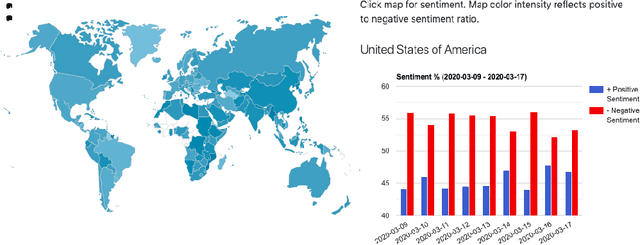
Abstract:The ongoing Coronavirus Disease (COVID-19) pandemic highlights the interconnected-ness of our present-day globalized world. With social distancing policies in place, virtual communication has become an important source of (mis)information. As increasing number of people rely on social media platforms for news, identifying misinformation has emerged as a critical task in these unprecedented times. In addition to being malicious, the spread of such information poses a serious public health risk. To this end, we design a dashboard to track misinformation on popular social media news sharing platform - Twitter. The dashboard allows visibility into the social media discussions around Coronavirus and the quality of information shared on the platform, updated over time. We collect streaming data using the Twitter API from March 1, 2020 to date and identify false, misleading and clickbait contents from collected Tweets. We provide analysis of user accounts and misinformation spread across countries. In addition, we provide analysis of public sentiments on intervention policies such as "#socialdistancing" and "#workfromhome", and we track topics, and emerging hashtags and sentiments over countries. The dashboard maintains an evolving list of misinformation cascades, sentiments and emerging trends over time, accessible online at \url{https://usc-melady.github.io/COVID-19-Tweet-Analysis}.
A Deep Structural Model for Analyzing Correlated Multivariate Time Series
Jan 02, 2020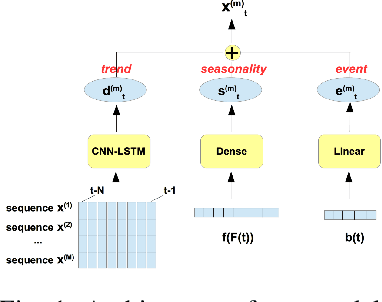
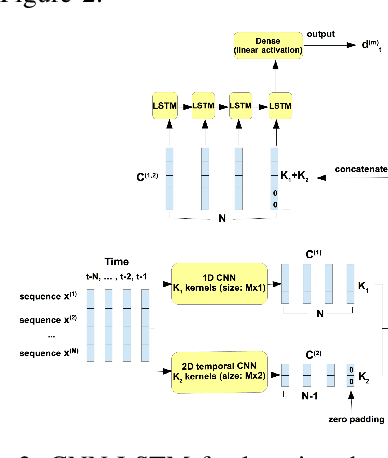
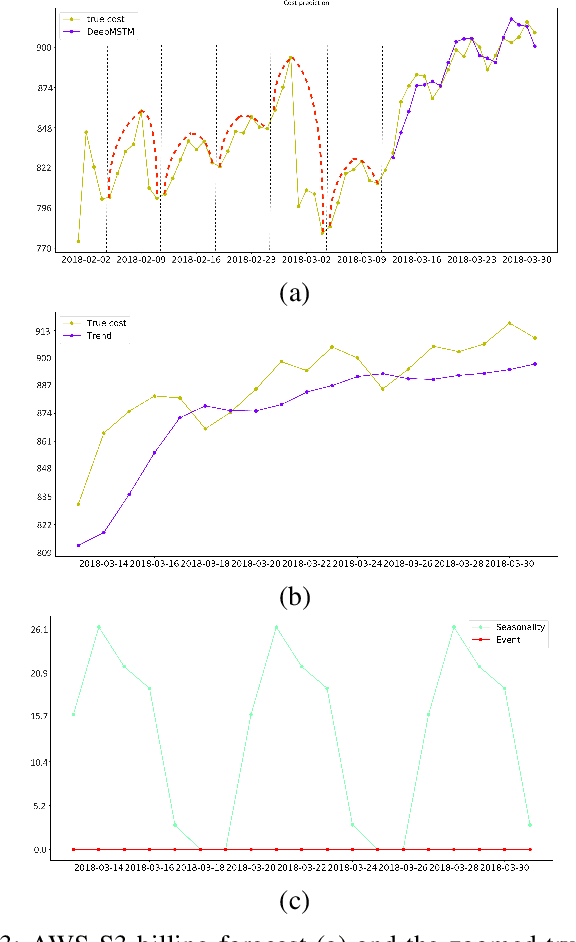
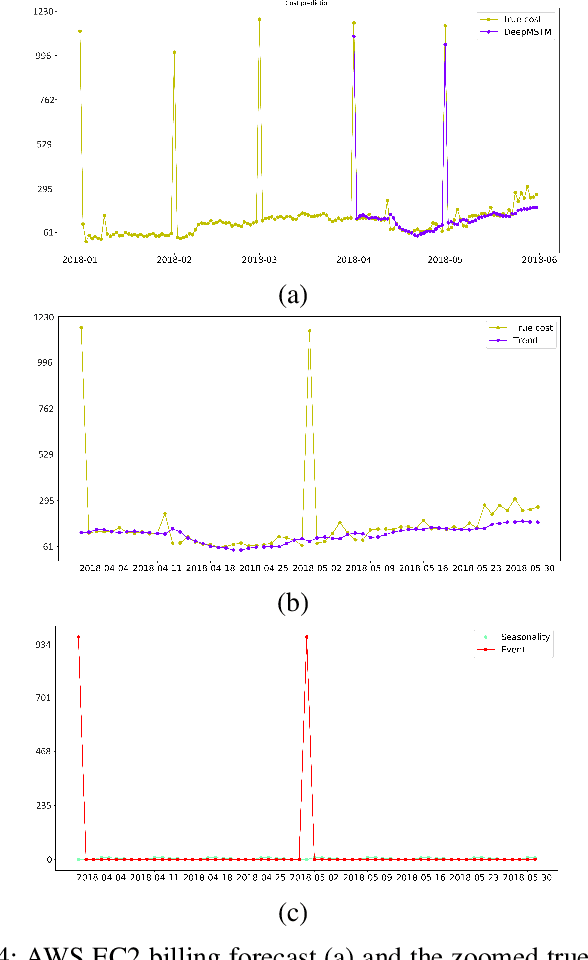
Abstract:Multivariate time series are routinely encountered in real-world applications, and in many cases, these time series are strongly correlated. In this paper, we present a deep learning structural time series model which can (i) handle correlated multivariate time series input, and (ii) forecast the targeted temporal sequence by explicitly learning/extracting the trend, seasonality, and event components. The trend is learned via a 1D and 2D temporal CNN and LSTM hierarchical neural net. The CNN-LSTM architecture can (i) seamlessly leverage the dependency among multiple correlated time series in a natural way, (ii) extract the weighted differencing feature for better trend learning, and (iii) memorize the long-term sequential pattern. The seasonality component is approximated via a non-liner function of a set of Fourier terms, and the event components are learned by a simple linear function of regressor encoding the event dates. We compare our model with several state-of-the-art methods through a comprehensive set of experiments on a variety of time series data sets, such as forecasts of Amazon AWS Simple Storage Service (S3) and Elastic Compute Cloud (EC2) billings, and the closing prices for corporate stocks in the same category.
Differentiable Physics-informed Graph Networks
Feb 11, 2019

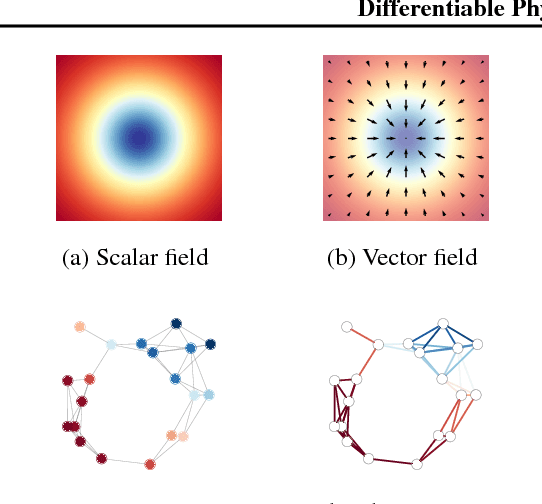
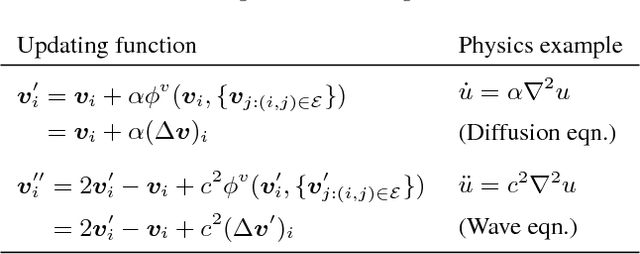
Abstract:While physics conveys knowledge of nature built from an interplay between observations and theory, it has been considered less importantly in deep neural networks. Especially, there are few works leveraging physics behaviors when the knowledge is given less explicitly. In this work, we propose a novel architecture called Differentiable Physics-informed Graph Networks (DPGN) to incorporate implicit physics knowledge which is given from domain experts by informing it in latent space. Using the concept of DPGN, we demonstrate that climate prediction tasks are significantly improved. Besides the experiment results, we validate the effectiveness of the proposed module and provide further applications of DPGN, such as inductive learning and multistep predictions.
CSI: A Hybrid Deep Model for Fake News Detection
Sep 03, 2017



Abstract:The topic of fake news has drawn attention both from the public and the academic communities. Such misinformation has the potential of affecting public opinion, providing an opportunity for malicious parties to manipulate the outcomes of public events such as elections. Because such high stakes are at play, automatically detecting fake news is an important, yet challenging problem that is not yet well understood. Nevertheless, there are three generally agreed upon characteristics of fake news: the text of an article, the user response it receives, and the source users promoting it. Existing work has largely focused on tailoring solutions to one particular characteristic which has limited their success and generality. In this work, we propose a model that combines all three characteristics for a more accurate and automated prediction. Specifically, we incorporate the behavior of both parties, users and articles, and the group behavior of users who propagate fake news. Motivated by the three characteristics, we propose a model called CSI which is composed of three modules: Capture, Score, and Integrate. The first module is based on the response and text; it uses a Recurrent Neural Network to capture the temporal pattern of user activity on a given article. The second module learns the source characteristic based on the behavior of users, and the two are integrated with the third module to classify an article as fake or not. Experimental analysis on real-world data demonstrates that CSI achieves higher accuracy than existing models, and extracts meaningful latent representations of both users and articles.
 Add to Chrome
Add to Chrome Add to Firefox
Add to Firefox Add to Edge
Add to Edge